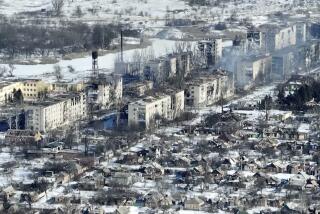COLUMN ONE : Failure Is Etched in Steel : The world’s largest steelworks, antiquated and ailing, stands as a symbol of a Soviet economy run by central planners who focused on little besides production statistics.
MAGNITOGORSK, Soviet Union — Across the Ural River, in the scrubby fields where Europe turns into Asia, it rises like a monster against the hazy sky: 50 smokestacks towering over a rusty fortress of factories, pipelines and train tracks.
It is the largest steelworks in the world, a monument to brute industrial power, decades of sacrifice--and an economic system that doesn’t work any more.
In this troubled factory town, where the steelworks runs everything from maternity wards to funeral services, people are proud that their efforts helped win World War II and build a superpower.
The question is, does a changing world economy still have room for the antique mills of Magnitogorsk and the city they have spawned?
“Times are changing, and I don’t trust the changes,” worries Rosa Dolzhikova, 53, an auburn-haired quality controller. “I feel lost--I don’t know anything.”
Throughout the Soviet Union, once-bustling industrial centers are now hobbled by obsolete technology, polluted air and a scarcity of consumer goods even by Soviet standards. Yet, as the nation hunkers down for a cold and possibly hungry winter, no fix is in sight. Political confusion and financial crisis continue to cloud any solution for ailing industry--except a rescue from the West.
The dilemma takes on special meaning in Magnitogorsk, the classic Soviet model of a city created for one purpose alone: to feed a nation’s ravenous appetite for steel. The air is filthy, the equipment is archaic. Steel output is falling, and store shelves are nearly empty.
This ailing industrial colossus is, in effect, a symbol of the Soviet economy, built--and ultimately failed--by central planners who focused for years on little besides raw production statistics.
“Magnitogorsk is a great metaphor for the whole problem of how to pay for--and who will pay for--70 years of Soviet mismanagement,” declares Abraham S. Becker, director of the RAND/UCLA Center for Soviet Studies in Los Angeles.
For all the problems, however, there is something mythic about Magnitogorsk and the rolling hills that surround this city of 440,000 in the southern Urals.
The legends start with Magnetic Mountain. According to local lore, the mountain once was so extraordinarily rich in iron ore that it pulled the arrows of Genghis Khan’s soldiers off course when they invaded Russia in the 13th Century. People here tell age-old tales of horses and men with metal shoes getting stuck on the mysterious mountain.
Modern history is a blend of idealism and tragedy. Thousands of laborers have devoted their lives to the steelworks since the late 1920s, when dictator Josef Stalin set out to exploit the region’s economic potential.
Early on, government recruiters encouraged people to join the grand effort. But not all calls were voluntary.
Perhaps one-third of the workers who built the steelworks in the late 1920s and 1930s were forced from their homes into the Spartan barracks of Magnitogorsk, according to historians. Typically, they were kulaks --peasants thrown off their own farms when Stalin’s regime created new, state agricultural enterprises.
That group of unhappy pioneers is dying off, but their sacrifice is remembered.
Vladimir Lactiomov, 23, recalls his grandfather as a man with a “long white beard and clever eyes” who taught him how to grow tomatoes as a little boy in the mid-1970s. “My grandmother and grandfather were rich,” says Lactiomov, an air traffic controller who is organizing an English-language club in the city. “They worked in the field for 24 hours. They had a horse.”
After the Bolshevik Revolution, though, they were forced off their farm in the Ukraine and ended up in barracks at Magnitogorsk, dismal shelters with little heat and no plumbing. “He was very angry,” Lactiomov said of his grandfather. “After he died, my parents told me about it.”
Such personal traumas pale beside what came later. In the late 1930s, a Stalinist purge was to savage the leadership of this hard-toiling city. American author Stephen Kotkin chronicles the dark period in his 1991 book about Magnitogorsk, “Steeltown, USSR”:
“The terror of 1937-38 hit Magnitogorsk like a cyclone: midnight arrests, torture, hysterical informing, venomous secret and public denunciations, suicides, disappearances without trace, executions. . . . Every top-level party figure or factory executive who had ever worked in the city, with one exception, was shot, if he or she had not already committed suicide.
“The police themselves, those who zealously carried out the terror, were eventually arrested and shot. . . . The episode remains largely mysterious to this day.”
The episode casts a shadow half a century later.
“Many people still don’t trust anything,” says Vladimir Shibrya, 61, a local historian, who confesses that until a few years ago, he wouldn’t even discuss the past except for cautious chats in his kitchen. Those who lived through the terror, he said, “don’t have confidence in themselves, even now.”
Yet if the older generation bears private scars, it also shares a proud memory that its children and grandchildren have only heard about in stories: that of the city’s heroic mobilization against Germany in World War II.
As Nazi troops menaced Russia, 38 industrial enterprises were evacuated to Magnitogorsk, more than 1,000 miles east of Moscow and safely removed from the battlefront. Demands on the steel town were infinite: Workers toiled in the factories for weeklong shifts, not even going home to sleep, according to Lubov Podluzhnova, director of the steelworks’ museum.
It’s hard to overstate the city’s role in the nation’s epic battle against Nazi Germany: One out of every three Soviet tanks, and one in three artillery shells, were made with Magnitogorsk steel, goes an oft-repeated observation here. Even the young can’t escape reminders of the war, such as the larger-than-life monument near City Hall (formerly Communist Party headquarters) that depicts a straight-backed steelworker handing a new sword to a Soviet soldier.
“We had a glorious past, a heroic past,” recalls Mikhail Vysotzky, 77, who started as a factory porter in 1933 and retired as a supervisor of 360 workers. “Even the kulaks who were sent here did a great job. They were heroes.”
And their work endures. Magnitogorsk continues to supply Soviet industry with steel--16 million tons at the 1989 peak, a critical element of the nation’s autos, machinery and equipment.
Such statistics, however, cannot capture the raw, even frightening power of the manufacturing monster born more than 50 years ago.
Inside the mills is a vision of hell: In one spot, a steelworker casually heats a tea kettle with an eight-foot blowtorch. Elsewhere, conveyers groan along the ceiling of a plant that is the size of a stadium; on the ground, something that looks like a giant bulldozer chugs back and forth on tracks, hauling debris. Iron melts in a red-hot row of ovens that sporadically shoot out flames. Heat fills the sweaty cavern of a room. There is a continual roar.
A white-brick hut stands inside an adjacent mill. It is a bomb shelter. Magnitogorsk, no doubt, has a prominent place on any U.S. list of strategic Soviet targets.
A roll of World War II labor heroes remains posted on the wall. The smell of hot oil is nauseating.
A few miles away, a chilly wind whips across the gorge that was the iron-rich core of Magnetic Mountain; thoroughly exploited, the mythic hill is now a deep hole. Down below, a couple of trucks are burying garbage. They look as small as toys.
As recently as the 1960s, the steelworks’ technology still met European standards, according to some experts.
For most of the industrialized world, however, the energy crisis of the early 1970s came as a wake-up call. Manufacturers moved to newer, more fuel-efficient forms of technology. In the West and Japan, metal producers responded, learning how to make the strong, lighter materials that were suddenly in demand.
But in the Soviet Union, which enjoyed a surplus of oil, “our general policy toward the metal industry was as if nothing had happened,” recalls Yegor T. Gaidar, director of the prestigious Institute of Economic Policy in Moscow. “We preserved all the old and inefficient equipment.”
And Magnitogorsk steel had plenty of customers, because of peculiar incentives built into the centralized Soviet economy. Makers of machinery and automobiles were scrambling to meet production quotas set by the government. Mimicking Western innovations or worrying about pollution were low priorities.
“Directors of the enterprises would always say they needed more iron,” Gaidar observed. “So why modernize the steelworks?”
If an endless parade of five-year plans didn’t build a consumer paradise, it did turn the Soviet Union into an industrial powerhouse. By the 1970s, the Soviet Union had surpassed the United States as world leader in iron and steel production. It continues to lead in those categories, as well as in production of concrete, cement powder, fertilizer and other basic products, according to PlanEcon, a Washington research group.
In the 1980s, however, new pressures on industrial centers--especially in cities sprinkled throughout the Ural Mountains, the northern Volga River region and eastern Siberia--were leading to confusion.
Suppliers were breaking deals with factories late in the decade, and central authorities seemed unable to stop them. A sinking ruble also meant that shipments of consumer products were increasingly based on swaps between large enterprises, rather than cash purchases. In this barter economy, regions that produced food, fuel or household items had the upper hand. Makers of metal or weaponry ranked down the list.
Dolzhikova, the cheerful quality controller who examines steel for scratches and other imperfections, can’t figure out why her town’s consumer offerings have grown so paltry. “In the years of stagnation, we had more than we have now,” she said, referring to a much-maligned period in the 1970s under then-President Leonid I. Brezhnev.
These days, citizens of Magnitogorsk also complain about air quality--and with reason.
The factory’s 900-bed hospital is filled with people with respiratory ailments; the city’s life expectancy is five years below that of the country overall, according to local officials.
“It’s impossible to live here,” said Victor Barabanov, an economist who suffers from emphysema. He suspects the environment not only for his own illness but for his father’s death from cancer at age 58.
Yet in a city that was built upon personal sacrifice, some residents--particularly the old--have little patience with the chorus of complaints--grievances that once would have been dangerous to voice. “I laugh when people say times are hard,” said Victor Archipov, 73, who remembers when workers needed a permission slip to turn on hot water. “They don’t know what hard times are.”
Other problems are jolting the gigantic steelworks.
Miners in Siberia are providing 25% less coal than had been counted on, a shortfall that once would have been scandalous. As a result, steel production may plunge 20% this year, plant officials said.
In response, managers are considering the radical step of layoffs. Overall, 60,000 are employed at various arms of the steelworks, including resorts, mineral springs, day care centers, health clinics, pig and cattle farms, commuter rail, sanitation and other city services.
To cure its varied ailments, the steelworks dreams of investment from abroad, specifically $2.5 billion to enhance quality and reduce pollution. A 33-member foreign relations staff has even been created to pursue outside help, and discussions have been held with potential investors from Germany and Japan. Factory managers also talk about splitting their giant enterprise into smaller units and establishing private control.
“We have the raw materials, and we have skilled, hard-working people,” declares Anatoly I. Starikov, general manager of the steelworks. “Speaking seriously,” he adds, “we need investment.”
In the meantime, antiquated equipment forces the factory to forgo projects with the West--and the hard currency it wants so badly. In one recent case, the steelworks had to turn down a job for a Finnish machine builder because the old technology couldn’t easily produce sheets of the right length.
Workers want modernization, too. Igor Prisyazhuk, 23, said his friends all ask to use the steelworks’ small amount of newer technology. Prisyazhuk, who operates machinery in a rolling mill, comes from a typical Magnitogorsk family; his father and uncle also labor at the factory.
But as a bunch of chickens run about in his back yard, the slender, blond-haired steelworker reveals he has a different livelihood in mind for his 2-year old son: a future in private business. “I hope he will be an entrepreneur,” said the father, as his child naps in the next room.
And for himself? Already a five-year factory veteran, Prisyazhuk has settled into life at the steelworks, the life it seems he and everyone in Magnitogorsk was born to lead. He asks: “Who would do the work instead of me?”
More to Read
Sign up for Essential California
The most important California stories and recommendations in your inbox every morning.
You may occasionally receive promotional content from the Los Angeles Times.










